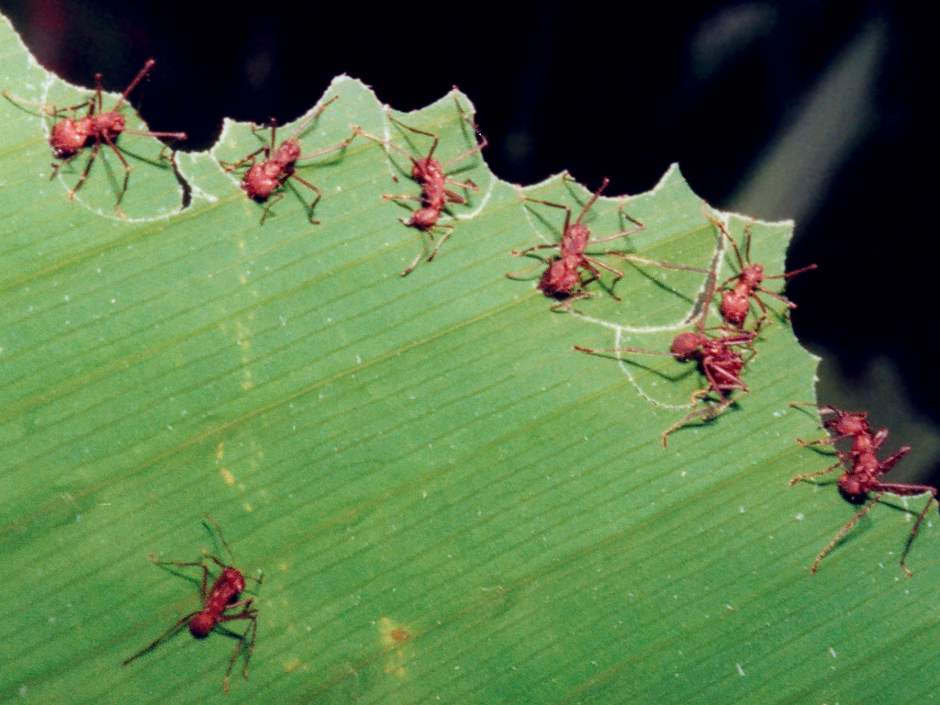
Internet, did you know that leafcutter ants are about the best farmers in the world? Or maybe termites are, or it could be ambrosia beetles, I’m not sure. Why am I telling you this? And why do I keep linking you to pictures of bugs? Because bugs are totally neat, and if you aren’t already fascinated by insect fungiculture, you need to get on that pronto. You see, Internet, while it’s very impressive to see the vast, sweeping plains of farm fields in the midwest, or terraced farms in China or Peru, humans aren’t aren’t the only game in town when it comes to farms, and, really, we have never been. The three types of bugs I mentioned above (there are many species of leafcutter ants, termites, and ambrosia beetles, not all of them fungiculturists) are examples of insects that completely blow human farming techniques out of the water. Check out this fine piece of internet journalism from the blog Civil Eats: an interview with the entomologist Mark Moffett. In it, Dr. Moffett talks about the leafcutter ants he saw on a recent trip to Ecuador. Most people who see leafcutter ants carrying bits of leaves back to their nests assume the ants just eat the plants. Not so. They use the leaves as mulch for fungus gardens, which they maintain underground within their nests. The fungus gardens are inside chambers, with each garden about the size of a human brain (so two fists together) and similarly round and squishy looking. Over the years, these ant colonies get huge, going 20 or 30 feet underground and housing thousands (!) of fungus gardens, which feed millions of ants. The fungi they grow are a special species, too, that has adapted so closely to being raised by the ants that it can’t survive in the wild, nor can the ants eat anything else. The ants carefully weed their gardens, and spread pesticides, special bacteria they grow in their bodies, to help keep the fungi heathy. Sounds a lot like humans, right?
We cultivate plant and animal species for food, care for them, over time they become more and more adapted to domestication, until we rely on each other, as species, to survive. There’s one big difference with leafcutter ants: the ants go to incredible lengths to care for the environment they live in. Since they eat only one plant, and it cannot live without their care, this attention to the environment as a whole has been evolving in leafcutters for 50 million years and is the biggest reason they thrive today. They weed very carefully, and any fungus that becomes diseased is taken away to waste chambers buried deep underground, and the original garden chamber sealed off. This is why they farm their fungi in so many separate chambers: if a blight were to spread throughout the whole colony, the ants would all die. The backup plans and failsafes in these colonies are incredible, as is the ants’ attention to detail in their colonies. What humans could learn from leafcutters is this: the difference between living from drought to bumper crop is in how much care you put into keeping the environment healthy. These ants have lived in underground colonies long enough, and with a stable enough cultivated food supply to dig 30 feet down and half the size of tennis court (27’x39′ for doubles), with some waste chambers (those deep underground ones where diseased fungi go, as well as all the colony’s waste) big enough for a human to fit in. Think about it, Internet, just think about how long it would take ants to build that kind of thing, and how many ants must live in there to keep it all running. These colonies are enormously complex and efficient societies, all living on a monoculture food source, and they make it all work because huge amounts of that efficiency, the engines of ant progress, if you will, are focused on maintaining a healthy environment for the colony. They do nothing farmers don’t do, but there are no oil spills, no food poisoning debacles, no blights. Not because they don’t have the resources to let environmental disasters happen, on an ant-scale, but these things happen through neglect. And leafcutters don’t neglect their environment.
A prime example of both insect agriculture and humans causing their own food problems are bees. As you may already be aware, Internet, bees pollinate flowers, which is the only way those flowers can reproduce. Bees are the sole pollinators of many, many plants, including over 100 commercial crops just in the U.S. Bees are also dying like crazy. Scientists aren’t quite sure why, either, but most theories point to human causes, from pesticides to cell phone radiation to climate change. This ain’t a conspiracy theory, folks, bees are just dying and nobody knows why. It’s mostly bee colonies kept humans at this point, and organic bee farms are still doing alright, but that doesn’t mean it isn’t time to panic, because it is absolutely time to panic. Without bees, humans would be left with rice and cereal grains to eat, and that’s really it. Everything else is either pollinated by bees, or eats something that is. People of the internet, bees are heading for extinction, it’s probably our fault, nobody really knows why, and if they die, we’re gonna starve. I hate to be so melodramatic, but Colony Collapse Disorder (the vague term for whatever it is that is killing large numbers of bees) is terrifying.
So please, Internet, let’s be like the leafcutter ants. Let’s put as much work into caring for the environment around our farms as we do growing food on them, maybe even more work. It’s simply a matter of realizing that we need a new set of goals, and we need to get used to doing a little more work here and there. There is absolutely no way around it.
